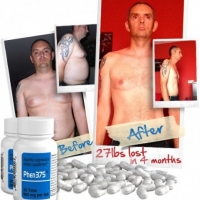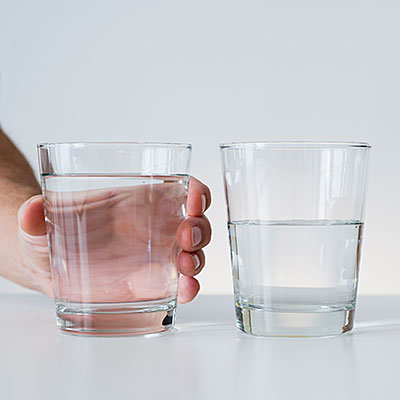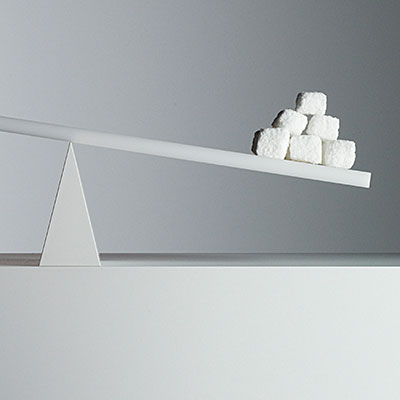 Getty Images Let's face it—fat has gotten an unfortunate rap. We curse the dimpled cellulite that has settled on our thighs and survey the pudge around our belly with a quick poke and a disapproving eye. But here's the thing: Fat isn't just a place where your body dumps extra calories. It's an organ that can help—or harm—your health. (One type, brown fat, can actually turn your body into a calorie-burning machine!) "Everyone has fat—even Olympic marathon runners," says Osama Hamdy, MD, medical director of the Obesity Clinical Program at Harvard University's Joslin Diabetes Center. "Simply put, we need it to survive." The trick is understanding the difference between the kinds of fat and keeping them in balance with diet, exercise and some plain old common sense. Get ready to go deep.
Getty Images Let's face it—fat has gotten an unfortunate rap. We curse the dimpled cellulite that has settled on our thighs and survey the pudge around our belly with a quick poke and a disapproving eye. But here's the thing: Fat isn't just a place where your body dumps extra calories. It's an organ that can help—or harm—your health. (One type, brown fat, can actually turn your body into a calorie-burning machine!) "Everyone has fat—even Olympic marathon runners," says Osama Hamdy, MD, medical director of the Obesity Clinical Program at Harvard University's Joslin Diabetes Center. "Simply put, we need it to survive." The trick is understanding the difference between the kinds of fat and keeping them in balance with diet, exercise and some plain old common sense. Get ready to go deep.
Where it is: Directly underneath your skin. Subcutaneous fat can be anywhere: not just in your belly and tush but your arms, legs—even your face.
Where it is: Nestled deep within your belly, where it pads the spaces around your abdominal organs. You can't feel or grab it.
Where it is: Mainly around your neck, collarbone and chest. For years, researchers assumed that it was present primarily in infants, helping to keep them warm, and that it gradually disappeared during childhood. But in 2009, studies revealed that some adults still have brown cells.
Next Page: The best way to calculate body fat percentage
The best way to measure your fat
The best way to determine whether you're carrying too much flab: Check your body fat percentage. A healthy range is between 20 and 25 percent for young women and up to 30 percent after age 50, Dr. Peeke says. Skip the skin calipers (they pinch the skin around your upper arm, thigh and stomach); results can be off by as much as 5 percent. Dr. Peeke's rec: an at-home bioelectrical impedance scale, which sends an electrical current through your body and measures how fast it returns. (Brands like Tanita can cost as low as $35.) Other methods, such as underwater weighing (you're dunked into a pool to measure your body fat) and DEXA scans (which use an X-ray to deter-mine body com-position, including body fat, lean muscle and bone density), are more accurate, but you'll have to go to a health clinic to get measured.
Skin dimples happen when subcutaneous fat cells collect in pockets and push against the connective tissue under your skin. Minimize their appearance by staying at a healthy weight and exercising—more muscle equals tauter skin. Caffeine-infused creams (like Clarins Body Lift Cellulite Control) can temporarily de-puff fat cells for a smoother look.
Ectopic fat has the same metabolic properties as visceral fat, but instead of padding your abdominal organs, it settles in your heart, liver, pancreas and muscles. "Most of us have only a few pounds of ectopic fat," Dr. Hamdy says. "Even so, it's dangerous because it's inside vital organs and can increase the risk of heart disease, liver damage and type 2 diabetes." The best way to tell if you have ectopic fat is by getting an MRI or a CT scan. Keep it at bay by staying active. The more you sit, the more likely you are to have this fat around your heart, according to a University of California, San Diego study.
Next Page: How to burn fat faster
3 ways to burn flab faster
Resistance train: A strength workout that incorporates high intensity interval training (HIIT) will help burn calories—and fat stores—at a higher rate than straight sets, says trainer Gunnar Peterson. The drill: Do eight reps of different types of body-weight resistance activities (chin-ups, squats, burpees, etc.), alternating 20 seconds of work with 10 seconds of rest.
Dairy: People who downed more dairy while on a low-calorie diet lost 2 1/2 more pounds of fat than those who didn't, according to a review published in the International Journal of Obesity.
Some research says yes, but a 2013 study found that while overweight people may have a higher life expectancy than normal-weight folks, they spend those years in poorer health. "While certain types of fat—particularly subcutaneous fat—may not have the impact on your heart that visceral fat does, they can affect your quality of life," Dr. Peeke says. "If you're heavy, you're more likely to develop osteoarthritis or just have trouble moving around."
Next Page: 7 ways fact affects your whole body
7 ways fact affects your whole body
Your head: The risk of migraines increases by almost 40 percent in younger women with general or belly obesity, according to the American Headache Society.
Next Page: How fat changes as you age
How fat changes as you age
Childhood: The number of fat cells you have is set early on, so you don't actually get more of them when you gain weight. Instead, those fat cells swell as triglycerides (i.e., fatty acids) are stored in them. If enough fat cells expand in size, your body begins to, well, expand too. Boys tend to be born with more fat cells in their belly, while girls are born with more fat cells in their hips, thighs and butt, in preparation for storing fat during pregnancy.




